The Musicarta Canon Project Module Thirteen
Melodic Variations
The Canon chord sequence is ideal for learning to create melodies around chord tones. One way to do this is to sketch out the ‘contour’ of a sample two-bar melodic fragment and identify what chord tone it starts on. The Canon chord sequence’s regular structure allows you to fill out an entire eight-bar chorus by repeating the same fragment – with minor variations. A development of the melody fragment usually follows, and in this way a whole performance can be built up.
Here is the module performance.
Structure of the Canon chord sequence
The regular internal structure of the Canon chord sequence was pointed out when you were learning the bass line in Module Two. The essential points are:
- There are four pairs of chords.
- In the first three pairs of chords, the root falls a fourth.
- The first three pairs overlap by one scale tone.
- The last pair is a different, get-back-to-the-starting-place pair.
Play through any simple arrangement of the Canon chord sequence and check that you can identify these features. You will see them clearly in the bass line diagrams in the next section.
Describing melody by contour
One important aspect of a melody is its up/down shape, as seen from the side – its ‘contour’.
Here is the familiar Canon bass line.
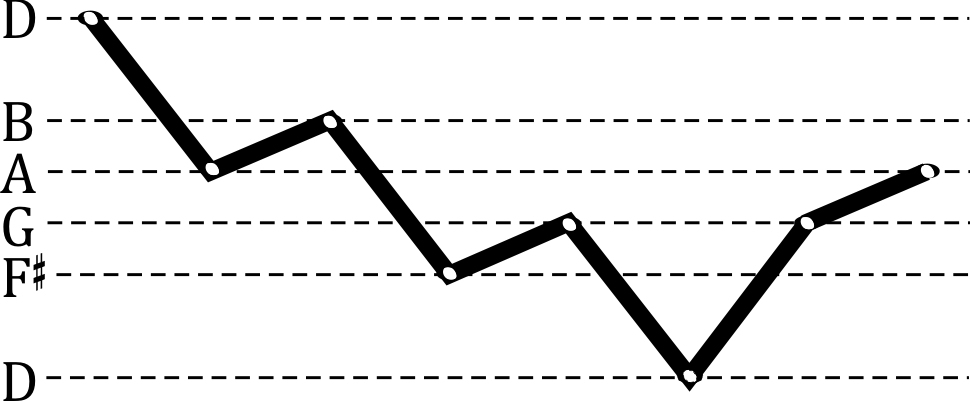
If we fill in the space underneath we get a silhouette, which gives a clearer picture of its contour.
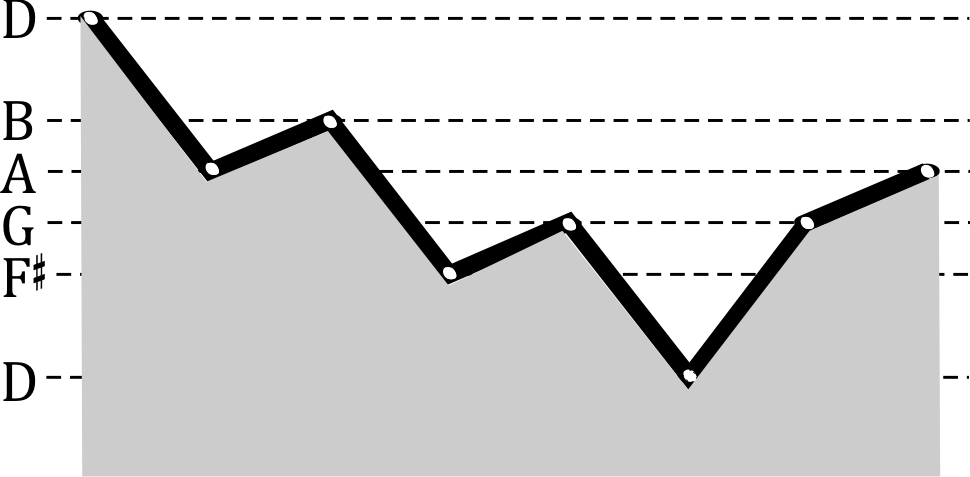
The simplest way to describe contour is to use arrows to indicate same, up or down movement between notes.

Here is the bass line with the right arrows for the slopes of the silhouette (contour) put in.
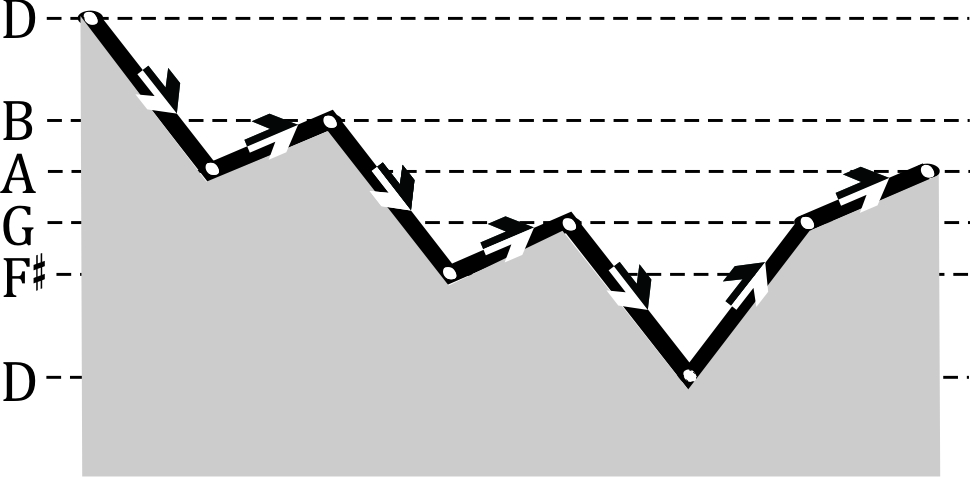
Here is the bass line as just a series of dots (representing the notes) with the contour arrows between them representing the up/down movement. (There isn’t a ‘stays-the-same’ in the Canon bass line.) Play the bass line from this illustration, starting on D.

Note that the shorthand doesn’t tell you how much higher or lower the next note is.
Describing melodic fragments by rhythm
Another obvious defining aspect of a melody is the rhythm of the notes.
Here is one chorus of the module performance.
Listen carefully, a number of times. You want to first isolate the top line of notes (the melody) in your ear, then notate (or just remember) the rhythm of the melody notes.
If we notate just the rhythm, we discover the four pairs of bars all have this rhythm.

This is a Musicarta ‘beat map’, showing just the rhythm of the right and left hand notes of the fragment in the audio. Tap out the stems-up notes with your right hand and the stems-down notes with your left hand (and/or a foot, if you can). You should hear something like this.
Establishing melodic contour
Copy out, right across a sheet of exam pad paper, the rhythmic pattern of the notes from the beat map above. It will look something like this:

This is the line of notes we want to sketch the ‘contour’ of by putting in the up, down or same arrows.
Listen again closely to the following performance clip – it’s slowed down to help you as you try to put arrows between the notes to indicate whether the note stays the same (i.e. repeats), or the melody goes up or down to the next note.
For now, you are only listening to the first three pairs of chords: D–A, Bm–F#m and G–D. As usual, the last pair is slightly different.
For example, is this right?

No! Not all the way through!
You might be able to do this almost
immediately or you might have to listen many times before you can identify the up/down/same
shape. (If you can play it by ear immediately, it’s because you have identified
the ‘contour’.)
You might find it easier to work from this clip – it’s just the first melodic fragment (the first pair of chords) repeated.
You can be fairly sure the fragment starts on a D major chord tone. If you play a D major triad where the music plays, you can probably find which one. The up/down movements are not big, so play around with next-door notes (D major scale tones) and see if you can pin the up/down/same profile down.
Working at your aural (listening) skills away from the keyboard is highly recommended. Here are some helpful techniques.
- Sing-and-listen to establish how many different pitches (heights of notes) there are in the fragment. There are ten notes in the fragment, but only _________ different pitches. (Working this out makes the task more manageable.)
- As you listen, scribble a series of ten dots representing the notes across a piece of exam pad paper, with the higher notes higher up the page and the lower notes lower down the page. Exaggerate the up/down distance. Just guess (it’s only paper!), and see if an up/down contour emerges.
- Sing along and scribble the line of dots just as above. You don’t have to be able to sing well or even remotely in tune – you can feel higher/lower/the same in your throat.
- Close your eyes and stab the air in front of you according to whether you think the note is higher or lower. Again, your muscles help you think about the pitch.
Here’s your sample again.
This is the correct sequences of arrows.

Identify the starting note
We have now successfully ‘contoured’ the first melodic fragment. It covers two chords – D and A (first pair of chords, first two bars).
We have said that identifying the contour of the fragment will be useful because we can repeat it and easily get a whole chorus of music out of it. But to do this we need to know what note to start playing the fragment on (if you haven’t already found out). You will want to be able to do this for yourself, by ear.
You can be fairly sure the fragment starts on a D major chord tone. If you play a D major triad up where the music plays, you can probably find which one. Try the chord tones in turn as you listen to or sing the first note of the melody fragment. Decide which chord tone the melody fragment starts on.
The melody fragment starts on note F sharp. The chord is D major – F sharp is the ‘third’ of D major.
Repeating the melodic fragment
The melody fragment starts on the third of the first chord in the pair, so you will start playing the next melody fragment on the third of B minor, the first chord in the next pair. The third of B minor is note D.
Play the melody fragment in the right hand starting on note D, following the up/down/same arrows. All the notes are next-door notes (D major scale tones). Then put the B minor and F sharp minor R, 5, 8, 10 accompaniment patterns underneath it.
The next pair of chords is G–D, so we play the melody fragment from ‘the third of G’. (To find ‘the third’, count three letter names, including G.)
You have now filled three-quarters of a whole chorus using your contour knowledge and the starting-note key.
Contour for the last pair of chords
Our examination of the Canon chord sequence structure revealed three pairs of chords the same (root falling a fourth) and one pair – the last pair – different. In the last pair of chords, the root rises from G to A; the melody will be different and we will have to discover the new ‘contour’.
Go back to your blank rhythmic pattern and listen to the relevant portion of the audio performance file, here repeated to give you a better chance to hear the contour.

Work at it until you’re sure your arrows truly represent the up/down movement of the melody fragment.
This is the correct sequence of arrows.

Check your answer carefully. If you have something different, listen again to the test segment until you ‘see with your ears’ where you’ve gone wrong. Correct your ‘contour template’.
The whole 8-bar chorus as contour
Take plenty of time to look-and-listen to the following ‘plan’ of the module performance – the chorus you have just built up.
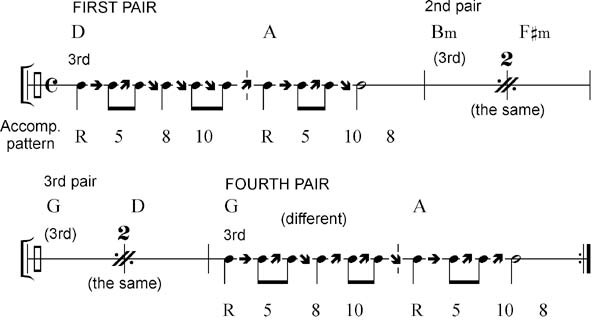
The diagram shows the four pairs of chords with the melody fragment contour written out in full in the first pair. The next two pairs are ‘the same’ – the contour is the same and starts on the 3rd of the chord – but using different chords, of course. (Note the handy two-bar repeat mark.) The fourth pair is ‘different’ because the contour is different – but the melody still starts on the 3rd of the chord.
A mixed-type accompaniment pattern which avoids doubling is shown.
The illustration shows the thought processes and abilities of the improvising, creative keyboard player, and studying it will train up your independent creative powers. With practice you can read the illustration as music and hear the notes as you look at it.
Moving from ‘reading the dots’ to taking charge of the music-creating is a quantum leap for most musicians, and you might have to ‘just sit with’ this new kind of notation for quite a while before you see the point.
Audio challenge
These two choruses have exactly the same rhythm as the module example. Make arrow sketches of the first three pairs of chords (always the same) and the last, 'tweaked' pair using the method worked through above.
Select bass accompaniment patterns (R, 5, 8, 10 or R, 5, 10, 8) to avoid doubling the chord tones of the melodic line. The MIDI files and plans of the two choruses are in the Answers section of the Workbook and at the bottom of this web page.
Improvising your own top line
Finally, listen to this improvisation on the module performance. It uses the step-wise ‘slash’ bass line with the bouncing bottom-top-top-bottom profile, and decorates the melody with ‘ornaments’ (trills and so on) and by delaying notes. It’s quite classical, but also a bit jazzy.
Try something similar yourself.
Answers
Here are the arrow diagrams and MidiPiano performances of the two audio challenge examples.
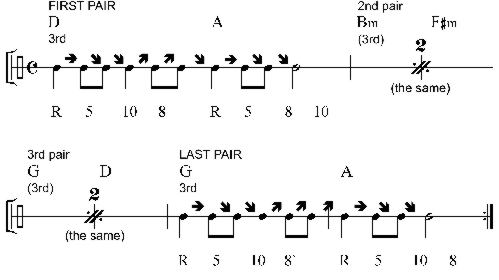
The second one.
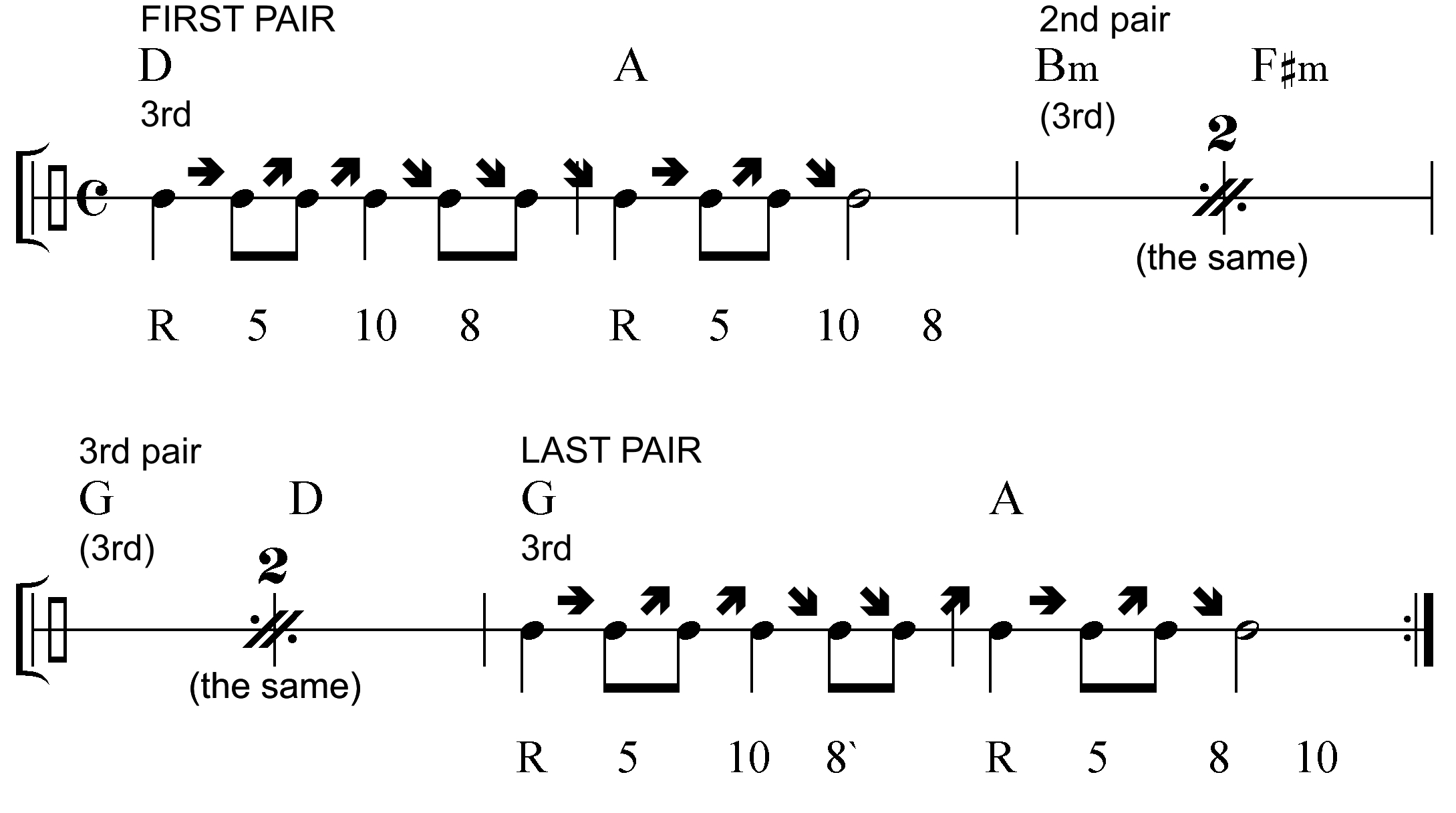
Thanks for visiting MUSICARTA! Come again soon!
|
|
Get an overview of Musicarta in manageable monthly slices – and keep up to date with new postings. Read all about it on the Musicarta Newsletter page. The Musicarta News - regular encouragement to learn and progress! Or – get the Musicarta RSS feed. [What’s that?] |
|
OUT NOW! |
THE MUSICARTA BEAT & RHYTHM WORKBOOK At last! An effective approach to keyboard rhythm & syncopation skills. Learn more! |
ONLY $24.95! |
THE MUSICARTA
|
THE MUSICARTA
|
The MusicartaA methodical approach to keyboard syncopation for
|
PUBLICATIONS
exciting keyboard
creativity courses
CHORDS 101
WORKBOOK

~HANON~
video course

Musicarta
Patreon
PENTATONICS
WORKBOOK
video course

Creative Keyboard
video course

BEAT AND RHYTHM
WORKBOOK

- Volume 1 -

12-BAR PIANO
STYLES WORKBOOK

MUSICARTA MODES
WORKBOOK

PIANO STYLE

CANON PROJECT
video course

VARIATIONS
video course


- Piano Solo -
video course

- Piano Solo -


YouTube playlists


